| October 09, 2008 |  |
MarsDaily Advertising Kit |
| Previous Issues | Oct 08 | Oct 07 | Oct 06 | Oct 05 | Oct 03 |
Nicaraguan Volcano Provides Insight Into Early Mars Moffett Field CA (SPX) Oct 01, 2008
Moffett Field CA (SPX) Oct 01, 2008Volcanic eruptions were commonplace on ancient Mars, when vents and fissures spewed out gases like water vapor, carbon dioxide, sulfur dioxide, and hydrogen sulfide. Such locales were very hot and very acidic - characteristics that would seem to be inhospitable to life. But in recent years researchers have discovered a vast array of primitive organisms living in analogous environments on Earth. ... more Mars Lander Sees Falling Snow, Soil Data Suggest Liquid Past  Pasadena CA (SPX) Sep 30, 2008
Pasadena CA (SPX) Sep 30, 2008NASA's Phoenix Mars Lander has detected snow falling from Martian clouds. Spacecraft soil experiments also have provided evidence of past interaction between minerals and liquid water, processes that occur on Earth. A laser instrument designed to gather knowledge of how the atmosphere and surface interact on Mars has detected snow from clouds about 4 kilometers (2. 5 miles) above the ... more The Ancient Rains Of Mars  Bonn, Germany (SPX) Sep 29, 2008
Bonn, Germany (SPX) Sep 29, 2008About four billion years ago, there were lakes on Mars which may have been fed by short-lived rivers that were, in turn, fed by precipitation. These lakes filled craters that were formed by the impact of meteorites. Water accumulated in places where rivers broke through the crater rims. Deltas were formed at the mouths of the rivers, similar to how they are formed where rivers flow into ... more Opportunity Slipping Like A Dune Buggy  Pasadena CA (JPL) Sep 29, 2008
Pasadena CA (JPL) Sep 29, 2008During the past week, Opportunity has been trying to reach a patch of dust between two crests of the ridge surrounding "Victoria Crater." The rover approached the ridge from the west, driving on flat ground, on Martian days, or sols, 1648 and 1650 (Sept. 12 and Sept. 14, 2008). Then, after reaching a staging position, Opportunity began to climb the ridge. That's when the rover's wheels beg ... more Mars Rover To Head Toward Bigger Crater  Pasadena CA (SPX) Sep 29, 2008
Pasadena CA (SPX) Sep 29, 2008NASA's Mars Rover Opportunity is setting its sights on a crater more than 20 times larger than its home for the past two years. To reach the crater the rover team calls Endeavour, Opportunity would need to drive approximately 12 kilometers (7 miles) to the southeast, matching the total distance it has traveled since landing on Mars in early 2004. The rover climbed out of Victoria Crater earlier ... more |
mars-mro
 spacetravel 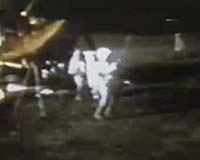 spacetravel  |
 Paris (AFP) Sept 25, 2008
Paris (AFP) Sept 25, 2008A novel experiment has dealt a setback to a theory that life on Earth was kickstarted by bacteria that hitched a ride on space rocks. The "pan-spermia" hypothesis is that cells were transported to the infant Earth on rocks that were bumped off other planets or even came from another star system. The theory gained a boost in 1996 when a group of US scientists proposed that a famous meteor ... more NASA marks 50th birthday, looks to new frontiers  Washington (AFP) Sept 25, 2008
Washington (AFP) Sept 25, 2008Half a century after NASA was created at the height of the Cold War when the United States sought to prove its superiority by winning the race to the Moon, the space agency faces new challenges ahead. At its conception NASA sought to assert American dominance over the Soviet Union, but in the new 21st century it finds an emerging rival in the space race: China. The birth of the National ... more Facts about NASA, the world's biggest space agency  Washington (AFP) Sept 25, 2008
Washington (AFP) Sept 25, 2008The National Aeronautics and Space Administration has the world's largest budget for space exploration with some 17 billion dollars on hand each year for space missions and robotic research. It was created by the US Congress in July 1958 to challenge the former Soviet Union's rise in the space race, a year after the Soviets launched the first artificial satellite, Sputnik, into space. ... more After Olympics, China eyes space conquest  Beijing (AFP) Sept 24, 2008
Beijing (AFP) Sept 24, 2008Flushed with success after a widely applauded Beijing Olympics, China will seek this week to further burnish its image with a new chapter in its quest to conquer space. Long-time Communist Party member Zhai Zhigang is slated to become the nation's first "taikonaut" to walk in space during the Shenzhou VII mission, China's third manned space flight, which is slated to blast off Thursday night ... more |
extrasolar
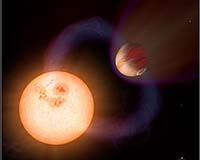 mars-mers 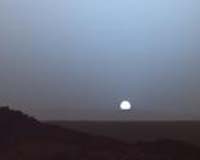 mars-phoenix 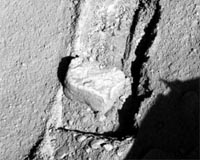 |
 Paris, France (ESA) Sep 23, 2008
Paris, France (ESA) Sep 23, 2008Scientists are now able to better explain why Mars's residual southern ice cap is misplaced, thanks to data from ESA's Mars Express spacecraft - the martian weather system is to blame. And so is the largest impact crater on Mars - even though it is nowhere near the south pole. Like Earth, Mars has frozen polar caps, but unlike Earth, these caps are made of carbon dioxide ice as well as ... more Growing Library Of Mars Spectrometer Images  Pasadena CA (SPX) Sep 23, 2008
Pasadena CA (SPX) Sep 23, 2008A September 2008 release of 1,575 new images, such as this one, from the Compact Reconnaissance Imaging Spectrometer (CRISM) on NASA's Mars Reconnaissance Orbiter brings the number of released, high-resolution CRISM images to 4,580. This image in enhanced color from visible-light wavelengths shows light-toned rugged highland material in an area near the Martian equator. It covers an area ... more Morning Frost In Trench Dug By Phoenix  Pasadena CA (SPX) Sep 23, 2008
Pasadena CA (SPX) Sep 23, 2008This image from the Surface Stereo Imager on NASA's Phoenix Mars Lander shows morning frost inside the "Snow White" trench dug by the lander, in addition to subsurface ice exposed by use of a rasp on the floor of the trench. The camera took this image at about 9 a.m. local solar time during the 113th Martian day of the mission (Sept. 18, 2008). Bright material near and below the ... more NASA's Phoenix Lander Might Peek Under A Rock  Tucson AZ (SPX) Sep 23, 2008
Tucson AZ (SPX) Sep 23, 2008If the robotic arm on NASA's Phoenix Mars Lander can nudge a rock aside, scientists on the Phoenix team would like to see what's underneath. Engineers who develop commands for the robotic arm have prepared a plan to try displacing a rock on the north side of the lander. This rock, roughly the size and shape of a VHS videotape, is informally named "Headless." "We don't know whether we ... more
|
mars-mers
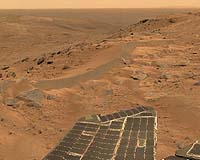 mars-mers 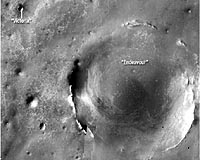 mars-mers 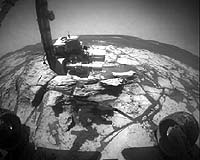 |
| Previous Issues | Oct 08 | Oct 07 | Oct 06 | Oct 05 | Oct 03 |
| The contents herein, unless otherwise known to be public domain, are Copyright 1995-2007 - SpaceDaily. AFP and UPI Wire Stories are copyright Agence France-Presse and United Press International. ESA Portal Reports are copyright European Space Agency. All NASA sourced material is public domain. Additional copyrights may apply in whole or part to other bona fide parties. Advertising does not imply endorsement, agreement or approval of any opinions, statements or information provided by SpaceDaily on any web page published or hosted by SpaceDaily. Privacy statement |